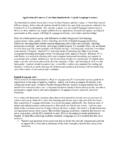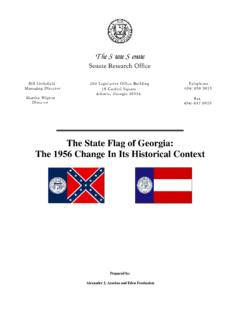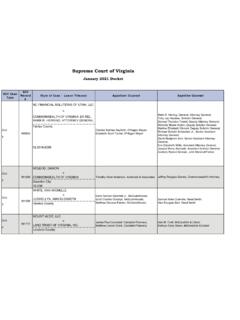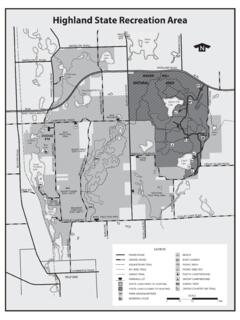Transcription of Advanced Decentralized Blockchain Platform Whitepaper ...
1 Advanced Decentralized Blockchain Platform Whitepaper Version: TRON Protocol Version: TRON Foundation December 10th, 2018, San Francisco 1. Introduction4 Vision4 Background4 History5 Terminology6 Address/Wallet6 ABI6 API6 Asset6 Bandwidth Points (BP)6 Block6 Block Reward6 Block Header6 Cold Wallet7 DApp7 gRPC7 Hot Wallet7 JDK7 KhaosDB7 LevelDB7 Merkle Root7 Public Testnet (Shasta)8 RPC8 Scalability8 SUN8 Throughput8 Timestamp8 TKC8 TRC-108 TRX8 2. Architecture9 Core10 Storage10 Blockchain Storage10 State Storage10 1 Application10 Protocol11 Protocol Buffers11 HTTP11 TRON Virtual Machine (TVM)11 Decentralized Exchange (DEX)11 Implementation12 3. Consensus13 Delegated Proof of Stake (DPoS)13 4.
2 Account16 Types16 Creation16 Structure16 5. Block18 Block Header18 Raw Data18 Witness Signature19 Block ID19 Transaction19 Signing19 Bandwidth Model19 Fee20 Transaction as Proof of Stake (TaPoS)20 Transaction Confirmation21 Structure21 6. TRON Virtual Machine (TVM)23 Introduction23 Workflow23 Performance25 Lightweight Architecture25 Robust25 High Compatibility25 Low Cost25 7. Smart Contract26 Introduction26 Energy Model26 Deployment27 2 Trigger Function27 TRON Solidity27 8. Token28 TRC-10 Token28 TRC-20 Token28 Beyond29 9. Governance30 Super Representative30 General30 Election30 Reward30 a. Vote Reward30 b. Block Reward31 c. Reward Calculation31 Committee32 General32 Dynamic Network Parameters32 Create Proposal36 Vote Proposal36 Cancel Proposal36 Structure36 10.
3 DApp Development37 APIs37 Networks37 Tools37 Resources37 11. Conclusion39 3 1. Introduction Vision TRON is an ambitious project dedicated to the establishment of a truly Decentralized Internet and its infrastructure. The TRON Protocol, one of the largest Blockchain -based operating systems in the world, offers public Blockchain support of high throughput, high scalability, and high availability for all Decentralized Applications (DApps) in the TRON ecosystem. The July 2018 acquisition of BitTorrent further cemented TRON s leadership in pursuing a Decentralized ecosystem. Background The introduction of Bitcoin in 2009 revolutionized society s perception of the traditional financial system in the wake of the Great Recession (2007-2008).
4 As centralized hedge funds and banks collapsed from speculation in opaque financial derivatives, Blockchain technology provided a transparent universal ledger from which anybody could glean transaction information. The transactions were cryptographically secured using a Proof of Work (PoW) consensus mechanism, thus preventing double spend issues. In late 2013, the Ethereum white paper proposed a network in which smart contracts and a Turing-complete Ethereum Virtual Machine (EVM) would allow developers to interact with the network through DApps. However, as transaction volumes in Bitcoin and Ethereum peaked in 2017, it was apparent from the low transaction throughput times and high transaction fees that cryptocurrencies like Bitcoin and Ethereum in their existing state were not scalable for widespread adoption.
5 Thus, TRON was founded and envisioned as an innovative solution to these pressing scalability challenges. 4 History The TRON Foundation was established in July 2017 in Singapore. In December 2017, TRON had launched its open source protocol. The Testnet, Blockchain Explorer, and Web Wallet were all launched by March 2018. TRON Mainnet launched shortly afterward in May 2018, marking the Odyssey release as a technical milestone. In June 2018, TRON declared its independence with the creation of the Genesis block, along with the July 2018 acquisition of BitTorrent. In October 2018, TRON launched the TRON Virtual Machine (TVM), a complete developers toolset, and 360 support system. The TRON roadmap involves combining BitTorrent s 100 million users with the TRON network via Project Atlas, as well as fostering the developer community to launch exciting new DApps on the TRON network.
6 11 is available at 5 Terminology Address/Wallet An address or wallet consisting of account credentials on the TRON network are generated by a key pair, which consists of a private key and a public key, the latter being derived from the former through an algorithm. The public key is usually used for session key encryption, signature verification, and encrypting data that could be decrypted by a corresponding private key. ABI An application binary interface (ABI) is an interface between two binary program modules; usually one of these modules is a library or an operating system facility, and the other is a user run program. API An application programming interface (API) is mainly used for user clients development.
7 With API support, token issuance platforms can also be designed by developers themselves. Asset In TRON's documents, asset is the same as token, which is also denoted as TRC-10 token. Bandwidth Points (BP) To keep the network operating smoothly, TRON network transactions use BP as fuel. Each account gets 5000 free daily BP and more can be obtained by freezing TRX for BP. Both TRX and TRC-10 token transfers are normal transactions costing BP. Smart contract deployment and execution transactions consume both BP and Energy. Block Blocks contain the digital records of transactions. A complete block consists of the magic number, block size, block header, transaction counter, and transaction data. Block Reward Block production rewards are sent to a sub-account (address/wallet).
8 Super Representatives can claim their rewards on Tronscan or through the API directly. Block Header A block header is part of a block. TRON block headers contain the previous block s hash, the Merkle root, timestamp, version, and witness address. 6 Cold Wallet Cold wallet, also known as offline wallet, keeps the private key completely disconnected from any network. Cold wallets are usually installed on "cold" devices ( computers or mobile phones staying offline) to ensure the security of TRX private key. DApp Decentralized Application is an App that operates without a centrally trusted party. An application that enables direct interaction/agreements/communication between end users and/or resources without a middleman.
9 GRPC gRPC (gRPC Remote Procedure Calls) is an open source remote procedure call (RPC) system 2initially developed at Google. It uses HTTP/2 for transport, Protocol Buffers as the interface description language, and provides features such as authentication, bidirectional streaming and flow control, blocking or nonblocking bindings, and cancellation and timeouts. It generates cross- Platform client and server bindings for many languages. Most common usage scenarios include connecting services in microservices style architecture and connecting mobile devices, and browser clients to backend services. Hot Wallet Hot wallet, also known as online wallet, allows user's private key to be used online, thus it could be susceptible to potential vulnerabilities or interception by malicious actors.
10 JDK Java Development Kit is the Java SDK used for Java applications. It is the core of Java development, comprising the Java application environment (JVM+Java class library) and Java tools. KhaosDB TRON has a KhaosDB in the full-node memory that can store all the newly-forked chains generated within a certain period of time and supports witnesses to switch from their own active chain swiftly into a new main chain. See State Storage for more details. LevelDB LevelDB was initially adopted with the primary goal to meet the requirements of fast R/W and rapid development. After launching the Mainnet, TRON upgraded its database to an entirely customized one catered to its very own needs. See Blockchain Storage for more details.





